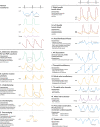The contemporary pulmonary artery catheter. Part 1: placement and waveform analysis
- PMID: 33564995
- PMCID: PMC8894225
- DOI: 10.1007/s10877-021-00662-8
The contemporary pulmonary artery catheter. Part 1: placement and waveform analysis
Abstract
Nowadays, the classical pulmonary artery catheter (PAC) has an almost 50-year-old history of its clinical use for hemodynamic monitoring. In recent years, the PAC evolved from a device that enabled intermittent cardiac output measurements in combination with static pressures to a monitoring tool that provides continuous data on cardiac output, oxygen supply and-demand balance, as well as right ventricular (RV) performance. In this review, which consists of two parts, we will introduce the difference between intermittent pulmonary artery thermodilution using cold bolus injections, and the contemporary PAC enabling continuous measurements by using a thermal filament which at random heats up the blood. In this first part, the insertion techniques, interpretation of waveforms of the PAC, the interaction of waveforms with the respiratory cycle and airway pressure as well as pitfalls in waveform analysis are discussed. The second part will cover the measurements of the contemporary PAC including measurement of continuous cardiac output, RV ejection fraction, end-diastolic volume index, and mixed venous oxygen saturation. Limitations of all of these measurements will be highlighted there as well. We conclude that thorough understanding of measurements obtained from the PAC are the first step in successful application of the PAC in daily clinical practice.
Keywords: Hemodynamic monitoring; Pulmonary artery catheter; Pulmonary artery pressure; Waveform characteristics.
© 2021. The Author(s).
Conflict of interest statement
ITB, ECB, and FdL do hereby declare that there are no conflict of interest. TWLS received research Grants and honoraria from Edwards Lifesciences (Irvine, CA, USA) and Masimo Inc. (Irvine, CA, USA) for consulting and lecturing and from Pulsion Medical Systems SE (Feldkirchen, Germany) for lecturing. TWLS is editor in chief of the Journal of Clinical Monitoring and Computing but had no role in the handling of this manuscript.
Figures



References
-
- Swan HJ, Ganz W, Forrester J, Marcus H, Diamond G, Chonette D. Catheterization of the heart in man with use of a flow-directed balloon-tipped catheter. N Engl J Med. 1970;283(9):447–51. - PubMed
-
- Gore JM, Goldberg RJ, Spodick DH, Alpert JS, Dalen JE. A community-wide assessment of the use of pulmonary artery catheters in patients with acute myocardial infarction. Chest. 1987;92(4):721–7. - PubMed
-
- Zion MM, Balkin J, Rosenmann D, Goldbourt U, Reicher-Reiss H, Kaplinsky E, et al. Use of pulmonary artery catheters in patients with acute myocardial infarction. Analysis of experience in 5,841 patients in the SPRINT Registry. SPRINT Study Group. Chest. 1990;98(6):1331–5. - PubMed
-
- Connors AF, Speroff T, Dawson NV, Thomas C, Harrell FE, Wagner D, et al. The effectiveness of right heart catheterization in the initial care of critically ill patients. SUPPORT Investigators JAMA. 1996;276(11):889–97. - PubMed
-
- Harvey S, Harrison DA, Singer M, Ashcroft J, Jones CM, Elbourne D, et al. Assessment of the clinical effectiveness of pulmonary artery catheters in management of patients in intensive care (PAC-Man): a randomised controlled trial. Lancet. 2005;366(9484):472–7. - PubMed
Publication types
MeSH terms
LinkOut - more resources
Full Text Sources
Other Literature Sources

